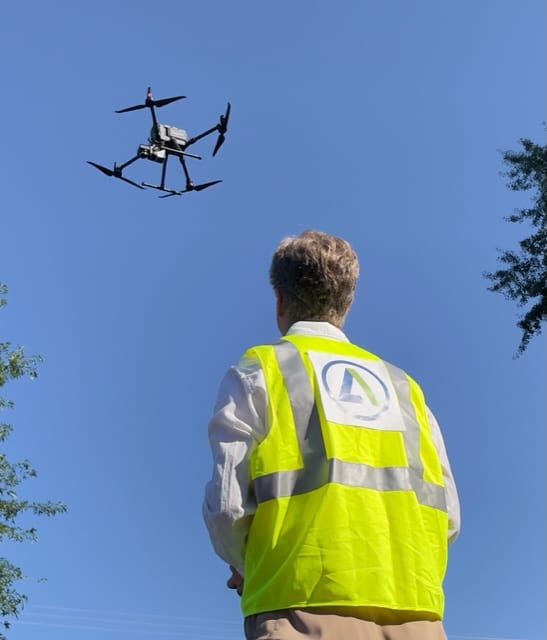Drones Are Going to Take Our Jobs: Dispelling Myths About UAVs in the Surveying Industry
Feb 06, 2023
Drone LiDAR technology is becoming increasingly popular in the surveying and mapping industry, but many traditional surveyors are still hesitant to adopt it for their projects. In this article, we will explore some of the barriers that traditional surveyors cite for not using unmanned aerial vehicles (UAVs) and how these myths can be dispelled.

Myth 1: The High Cost of LiDAR
One of the main myths surrounding the use of LiDAR for surveying projects is that it is more expensive than traditional surveying methods. However, this is not necessarily the case. While the initial investment for a drone LiDAR system is high, it can be more cost-effective in the long run.
A significant advantage of using drone LiDAR is that it can be done with fewer people in less time. This can significantly reduce the labor costs associated with traditional surveying methods. Drone LiDAR can also cover large areas much faster than conventional methods, which can help to speed up the overall project timeline. Additionally, the higher accuracy of LiDAR data can mean fewer revisits to the site to re-measure or re-survey areas, further reducing costs.
While LiDAR used to be expensive and time-consuming, now it only takes about 30 minutes of flying out in the field each day for an average project, and you can count on ROCK Cloud to do the heavy lifting of post-processing your data and deliverables for you.
Myth 2: Technology is a Barrier
Another barrier surveyors cite is a lack of experience and knowledge of LiDAR technology. However, many companies now offer training and support services, which can help surveyors gain the necessary experience and expertise to use drone LiDAR on their projects. Additionally, by learning this technology, surveyors can stay competitive in the industry and offer more advanced services to their clients.

Purchasing a ROCK Cloud Business plan subscription brings with it the benefit of Live Chat Support during business hours. You can chat from any ROCK Robotic webpage or directly from your ROCK Cloud project!
Connect with the ROCK Support Team to ask your questions and get real-time, real human support! Chat in for help, and the ROCK Support Team is always happy to point you in the right direction or work to find the answer that moves you forward.
We also offer email support at support@rockrobotic.com anytime. Email your questions and expect to hear back from a ROCK Support Team member with solutions! Visit our ROCK Solid Support page to learn more.
Myth 3: Drones Are Going to Take Our Jobs
We hear this one a lot from traditional surveying companies looking to dip their toes into the LiDAR pool. Some surveyors may be hesitant to adopt drone LiDAR technology because they believe it will automate their jobs and make them obsolete. However, this is not the case. Drones can actually increase the efficiency and accuracy of surveying and mapping projects, allowing surveyors to take on more challenging and complex projects. Drones simply can't replace the human element of surveying, such as decision-making, interpretation and analysis of data.
Drones simply can't replace the human element of surveying, such as decision-making, interpretation and analysis of data.

The surveying and mapping industry in the United States currently faces a shortage of qualified professionals. In reality, surveying jobs exceed surveying job seekers with no change in sight. According to the Bureau of Labor Statistics, employment of surveyors is projected to grow 4 percent from 2021 to 2031, much faster than the average for all occupations. However, the number of surveyors graduating from college or university programs is not keeping up with this projected growth, leading to a shortage of qualified professionals.
In fact, many companies are struggling to find qualified professionals to fill open positions. Based on our industry insight, hiring will not catch up anytime soon, but the demand for surveying work will only continue to increase. This leads to longer turnaround times for projects and increased client costs.
Myth 4: Drone Surveying Isn't as Accurate as Traditional Surveying
One of the myths surrounding the use of drones for surveying projects is that it is less accurate than using traditional methods. However, this is not necessarily the case. In fact, drone LiDAR technology can provide highly accurate and detailed data that can be used for a variety of applications, such as land use planning, infrastructure development, and disaster management.

One of the main advantages of using drone LiDAR is its high level of accuracy. The LiDAR sensor can capture millions of data points per second, which can be used to create highly detailed 3D models and maps. This level of detail can be much higher than what can be achieved with traditional surveying methods, such as total station or GPS. Additionally, LiDAR sensors (like ROCK's R360 and R2A) penetrate vegetation and dense forest, providing accurate data in areas that are difficult to access. Not only that, ROCK Cloud delivers an accuracy report for your point cloud data.
Simply stated, drone LiDAR captures data that is impossible to obtain with traditional methods and with greater accuracy.
LiDAR technology is revolutionizing the surveying and mapping industry, but traditional surveyors may still be hesitant to adopt it due to myths and misconceptions. By embracing this technology, surveyors can stay competitive in the industry and offer more advanced services to their clients. Drones are a crucial part of the surveying workflow you should be using.
Visit rockrobotic.com to learn more about our survey-grade hardware and processing software.